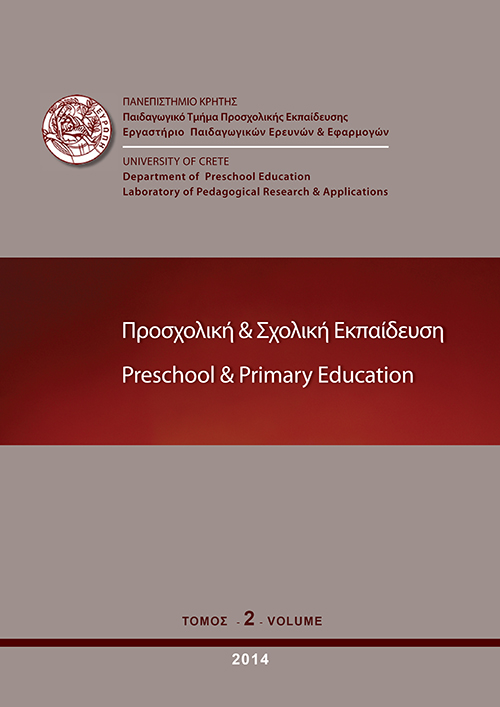European and Greek legislation on preschool children's protection from the use of unsafe toys
Περίληψη
Λεπτομέρειες άρθρου
- Πώς να δημιουργήσετε Αναφορές
-
Katsikonouri, E., & Riga, V. (2014). European and Greek legislation on preschool children’s protection from the use of unsafe toys. Preschool and Primary Education, 2, 27–44. https://doi.org/10.12681/ppej.37
- Τεύχος
- Τόμ. 2 (2014)
- Ενότητα
- Άρθρα

Αυτή η εργασία είναι αδειοδοτημένη υπό το CC Αναφορά Δημιουργού – Μη Εμπορική Χρήση – Παρόμοια Διανομή 4.0.
Οι συγγραφείς των άρθρων που δημοσιεύονται στο ΠΡΟΣΧΟΛΙΚΗ & ΣΧΟΛΙΚΗ ΕΚΠΑΙΔΕΥΣΗ διατηρούν τα δικαιώματα πνευματικής ιδιοκτησίας επί των άρθρων τους, δίνοντας στο περιοδικό το δικαίωμα της πρώτης δημοσίευσης. Άρθρα που δημοσιεύονται στο ΠΡΟΣΧΟΛΙΚΗ & ΣΧΟΛΙΚΗ ΕΚΠΑΙΔΕΥΣΗ διατίθενται με άδεια Creative Commons 3.0 και σύμφωνα με την άδεια μπορούν να χρησιμοποιούνται ελεύθερα, με αναφορά στο/στη συγγραφέα και στην πρώτη δημοσίευση για μη κερδοσκοπικούς σκοπούς και με δικαίωμα τροποποίησης μόνον με παρόμοια διανομή (αν αναμείξετε, τροποποιήσετε, ή δημιουργήσετε πάνω στο υλικό, πρέπει να διανείμετε τις δικές σας συνεισφορές υπό την ίδια άδεια όπως και το πρωτότυπο). To Εργαστήριο Παιδαγωγικών Ερευνών και Εφαρμογών του Παιδαγωγικού Τμήματος Προσχολικής Εκπαίδευσης του Πανεπιστημίου Κρήτης και το Εθνικό Κέντρο Τεκμηρίωσης διατηρούν το δικαίωμα να δημοσιεύουν, να αναπαραγάγουν, να παρουσιάζουν στο κοινό, να διανέμουν και χρησιμοποιούν άρθρα που δημοσιεύονται στο ΠΡΟΣΧΟΛΙΚΗ & ΣΧΟΛΙΚΗ ΕΚΠΑΙΔΕΥΣΗ σε οποιοδήποτε μέσο και μορφή είτε μεμονωμένα είτε ως μέρη συλλογικών έργων, για όλο το χρόνο διάρκειας προστασίας της πνευματικής ιδιοκτησίας και για όλες τις χώρες του κόσμου. Αυτό περιλαμβάνει ενδεικτικά και όχι αποκλειστικά, το δικαίωμα δημοσίευσης των άρθρων σε τεύχη του περιοδικού ΠΡΟΣΧΟΛΙΚΗ & ΣΧΟΛΙΚΗ ΕΚΠΑΙΔΕΥΣΗ, αναπαραγωγής και διανομής μεμονωμένων αντιγράφων των άρθρων, αναπαραγωγής ολόκληρων των άρθρων σε άλλη έκδοση του Εργαστηρίου Παιδαγωγικών Ερευνών και Εφαρμογών του Παιδαγωγικού Τμήματος Προσχολικής Εκπαίδευσης του Πανεπιστημίου Κρήτης και του Εθνικού Κέντρου Τεκμηρίωσης και αναπαραγωγής και διανομής των άρθρων ή περίληψης αυτών με χρήση πληροφορικού συστήματος αποθετηρίου.
Λήψεις
Αναφορές
Bennett, N., Wood, L., & Rogers, S. (1997). Teaching through Play: Teachers' thinking and classroom practice. Buckingham: Open University Press.
Bradley, R. H. (1985). Social-cognitive development and toys. Topics in Early Childhood Special Education, 5(3), 11-30, DOI: 10.1177/027112148500500303
Brougère, G. (2006). Toy houses: a socio-anthropological approach to analysing objects. Visual Communication, 5(1), 5-24, DOI: 10.1177/1470357206060916
Brougère, G., & Manson, M. (1989-1990). Images et fonctions sociales du jouet anthropomorphe. Etudes et Documents, 2, 66-84.
Corsaro, W. (1997). The sociology of childhood. London: Pine Forge Press.
Cross, G. (1997). Kids' stuff. Toys and the changing world of American childhood. Cambridge, MA: Harvard University Press.
Dixon, B. (1990). Playing them false: A study of children's toys, games and puzzles. London: Trentham Books.
Frost, J. (2010). A history of play and play environments. London/New York, NY: Routledge.
Garvey, C. (1990). Play: the developing child (in Greek). Athens: Koutsoubos.
Goncu, A. (1993). Development of intersubjectivity in the dyadic play of preschoolers. Early Childhood Research Quarterly, 8, 99-116, DOI: 10.1016/S0885-2006(05)80100-0
Gougouli, Κ., & Kouria, Α. (Eds.). (2000). Child and play in modern society (19th and 20th century) (in Greek). Athens: Kastaniotis.
Hillman, M., Adams, J., & Whitelegg, J. (1990). One false move… A study of children's independent mobility. London: Policy Studies Institute.
Hofferth, S. L., & Sandberg, J. F. (2001). Changes in American children's time, 1981-1997. Demography, 38(3), 423-436.
Howes, C. (1992). Sequences in the development of competent play with peers: Social and social pretend play. Developmental Psychology, 28(5), 961-974, DOI: 10.1037/0012-1649.28.5.961
Hutt, S. J., Tyler, S., Hutt, C., & Cristopherson, H. (1989). Play, exploration and learning: A natural history of the preschool. London: Routledge.
Kehily, M. J. (2004). An introduction to childhood studies. Maidenhead/New York, NY: Open University Press.
Kline, S., & Pentecost, D. (1990). The characterization of play: Marketing children's toys. Play and Culture, 3(3), 235-254.
Langer, B. (2002). Commodified enchantment: Children and consumer capitalism. Thesis Eleven, 69, 67-81, DOI: 10.1177/0725513602069001005
Linn, S. (2008). The case for make believe: Saving play in a commercialized world. New York, NY: The New Press.
Marcuse, H. (1964). One-dimensional man: Studies in the ideology of the advanced industrial society. Boston, MA: Beacon Press.
Mendez, J. L., McDermott, P. A., & Fantuzzo, J. W. (2002). Identifying and promoting social competence with African American preschool children: Developmental and contextual consideration. Psychology in the Schools, 39, 111-123. DOI: 10.1002/pits.10039
Miller, D. (1987). Material culture and mass consumption. Oxford: Blackwell.
Piaget, J. (1979). Psychology and Pedagogy (in Greek). Athens: Nea Synora.
Pugh, A. J. (2005). Selling compromise: Toys, motherhood, and the cultural deal. Gender & Society, 19(6), 729-749. DOI: 10.1177/0891243205279286
Sutton-Smith, B. (1986). Toys as culture. New York, NY: Gardner Press.
Trevarthen, C. (2001). How and why babies communicate (in Greek). In G. Kougioumtzakis (Ed.), Progress in the development of first years psychology (in Greek) (pp. 13-32). Heraklion: University of Crete Publications.
Van Gils, J. (2007, September). The UN Convention on the Rights of the Child and the evolution of children's Play. Paper presented at the ICCP Conference in Brno, Czech Republic.
Winnicott, D. W. (1987). The child, the family, and the outside world. Cambridge, MA: Perseus Publishing.
Zelizer, V. (1985). Pricing the priceless child. The changing social value of children. New York, NY: Basic Books.



